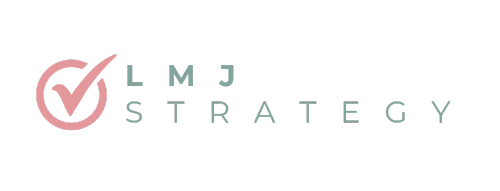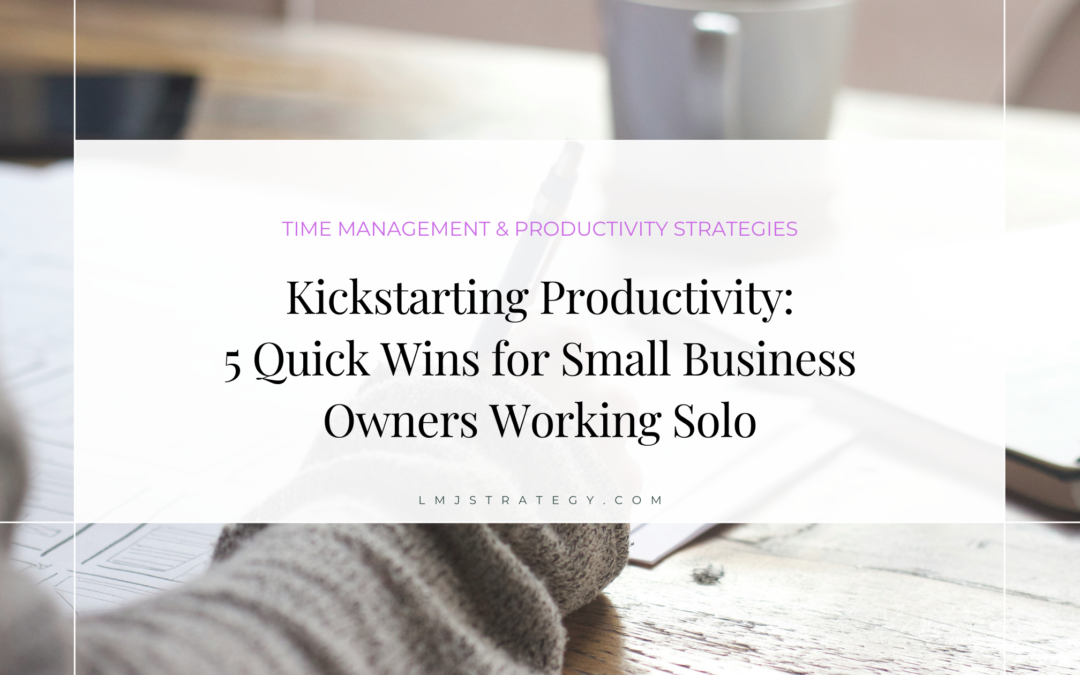If you’re a solopreneur, you’ve probably felt the “too much to do, not enough time” struggle more than once. Maybe you need to boost your productivity! From managing clients to handling marketing, admin work, and more, the daily to-do list can feel endless. Bringing in support can be a game-changer, but it’s often easier said than done if you’re not ready or you’re unsure how to start delegating effectively.
The good news? You don’t need an entire team to boost your productivity. Sometimes, small adjustments can make a big difference.
Here’s a look at five productivity ‘quick wins’ crafted specifically to help solopreneurs get organized, regain clarity, and reduce overwhelm.
Quick Win #1: Prioritize with the Eisenhower Matrix for Clarity and Delegation Prep
The Eisenhower Matrix is a powerful tool to boost productivity for solopreneurs because it not only helps you prioritize your tasks, it also highlights what’s worth delegating once you’re ready. The matrix divides tasks into four categories:
- Urgent and Important: Do these tasks as soon as possible.
- Not Urgent but Important: Schedule these tasks for a later time.
- Urgent but Not Important: Delegate these when possible.
- Not Urgent and Not Important: Consider eliminating these tasks altogether.
With this tool, you can avoid the constant overwhelm of “putting out fires” and instead focus on activities that truly move your business forward. Setting SMART goals can further enhance your productivity. You’ll also start to see which tasks are ideal candidates for future delegation—freeing up time and energy to concentrate on your highest priorities as your business grows.

How to Use the Eisenhower Matrix:
- List Your Tasks at the start of each week or day, then sort them into the four categories.
- Focus First on the “Important and Urgent” Tasks to drive progress.
- Identify Delegation Opportunities by noting tasks that are Urgent but Not Important
Pro Tip: Visualize this list as a living document. The status of each task can and will often change. When you’re ready, these “Urgent but Not Important” tasks will be great options to hand off to a future team member.
Quick Win #2: Use “Role-Based” Time Blocking to Maintain Focus
Switching between tasks can be mentally draining, especially when you’re wearing all the hats in your business. Role-based time blocking allows you to stay focused by grouping similar tasks together under broader categories. Instead of tackling everything at once, you’ll work within just a few primary focus areas, which helps reduce overwhelm.
How to Simplify and Use Role-Based Time Blocking:
- Group Tasks into 3–4 Key Focus Areas rather than listing every role. For example, you might use categories like Client Work, Marketing & Growth, and Admin & Operations.
- Block Out Dedicated Times for each focus area in your schedule. During these blocks, ignore unrelated tasks—especially emails—unless they’re critical to that area.
- Stick to These Focus Areas throughout the week, using your Eisenhower Matrix to add any overflow tasks to the appropriate block instead of switching gears constantly.
Pro Tip: Focus areas can change as your business evolves. You’ll likely find that some areas need more time than others, and that’s okay! The key is to limit the number of categories and stay consistent with your time blocks.
Quick Win #3: Implement a “productivity Power Hour” for solopreneur Tasks
If admin tasks are constantly pulling you away from important work, try implementing a daily Power Hour. This is a set block of time where you knock out as many small, administrative tasks as possible, like emails, scheduling, or invoicing.
Why the Power Hour Works: Instead of spreading admin tasks throughout the day, grouping them into one burst of focused effort helps you avoid interruptions and stay on track with more impactful work.
How to Set Up Your Power Hour:
- Pick a Consistent Time each day (such as right after lunch) for your Power Hour.
- Challenge Yourself to complete as many admin tasks as possible within 60 minutes.
- Save Non-Urgent Tasks for tomorrow’s Power Hour to keep your workflow smooth.
Suggested Tasks for Power Hour: Email responses, invoicing, social media updates, scheduling appointments.
Quick Win #4: End-of-Day (EOD) Report to Set Boundaries and Capture Wins
Creating an End-of-Day (EOD) report is an easy way to bring your day to a close with clarity and intention. This quick report helps solopreneurs “clock out,” recognize productivity, set boundaries, and create a focused start for the next day.
Why an EOD Report Is a Game-Changer:
Solopreneurs often feel the pressure to keep working, even after hours. An EOD report marks the end of your workday, giving you a chance to reflect, document small wins, and wind down.
How to Create an EOD Report:
- Spend 5–10 Minutes reviewing your accomplishments and any challenges you faced.
- List Key Priorities for Tomorrow so that you can start your next day focused and ready.
- Capture One Win from the Day—recognizing even small successes can boost motivation and build momentum.
Pro Tip: Treat this report as a mini wrap-up that helps clear your mind, leaving you mentally “clocked out” and ready to recharge.
Quick Win #5: Build a Success Mindset by Tracking Wins and Visualizing Delegation
Productivity isn’t just about doing more—it’s about creating the right mindset to support growth. By celebrating daily wins and visualizing delegation, you can build confidence, reduce overwhelm, and prepare to bring in support when the time is right.
Step 1: Track Daily Wins to Recognize Progress
Recording small wins at the end of each day reinforces that you’re moving forward, even on busy days. This habit builds momentum and keeps you motivated.
- Add It to Your EOD Report by noting one win each day—anything from finishing a task to navigating a challenge.
- Reframe Challenges as growth opportunities and a part of your progress.
- Embrace Progress Over Perfection. Tracking wins helps you appreciate each step forward, even on less productive days.
Step 2: Visualize Delegation to Open Up to Future Support
Visualization can ease the idea of delegation by helping you imagine the benefits of handing off certain tasks to a team member.
- Picture the Relief of having a specific, time-consuming task handled by someone else.
- Envision the Outcome. Imagine the task completed smoothly, freeing you to focus on what matters most.
- Address Any Concerns by visualizing how delegation could help you grow rather than feeling like a loss of control.
Pro Tip: By combining this visualization with your daily wins, you’ll strengthen your success mindset and make it easier to delegate when the time is right.
Your Next Step to Building a Productive, Balanced Workday
When you’re running a business solo, it’s easy to feel bogged down by everything you “should” be doing. The five quick wins we covered here—using the Eisenhower Matrix, role-based time blocking, the Power Hour, COB reports, and a success mindset—are all simple, actionable ways to start working smarter without a major overhaul.
Remember, “Rome wasn’t built in a day.” Start with one tip, see how it feels, and build from there. These small changes can bring big clarity, improve work-life balance, and help you feel confident about managing and growing your business.
Are you ready to go from overwhelmed to organized? Book a free discovery call with me to explore your top productivity challenges and find solutions that fit your business.

